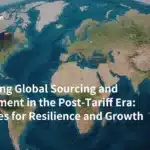In an era marked by geopolitical tensions and shifting trade policies, businesses worldwide are reevaluating their global sourcing and procurement strategies. The Trump administration’s tariffs, imposed between 2018 and 2025, left an indelible mark on supply chains, forcing companies to rethink their reliance on international markets. As we move into a post-tariff landscape, the lessons learned from this period are critical for building resilient, cost-effective, and agile supply chains. This article explores how organizations can leverage strategic global sourcing and local procurement to mitigate risks, optimize costs, and thrive in an unpredictable economic environment.
The Impact of Trump Tariffs on Global Sourcing
The tariffs introduced by the Trump administration targeted key trading partners, including China, the European Union, and Mexico. By 2020, tariffs on Chinese goods alone had risen to an average of 19.3%, up from 3% in 2018, according to the U.S. International Trade Commission (USITC). These policies aimed to reduce trade deficits and protect domestic industries but had unintended consequences for businesses reliant on global supply chains.
Data from the Federal Reserve Bank of New York revealed that U.S. companies bore 89% of the cost of these tariffs, with consumers shouldering the remaining 11% through higher prices. Companies faced rising import costs, disrupted supplier relationships, and increased operational complexity. For instance, manufacturers in sectors like electronics, textiles, and machinery saw their input costs surge, forcing many to seek alternative suppliers or shift production to other regions.
The Shift Toward Local Procurement
In response to tariff pressures, businesses accelerated the trend toward local procurement. A 2020 survey by the Reshoring Institute found that 60% of U.S. companies were actively reshoring or nearshoring production to reduce dependency on high-tariff regions. Mexico, in particular, emerged as a top destination, with manufacturing output in the country growing by 12% between 2018 and 2021. Similarly, Vietnam and India became popular alternatives for companies looking to diversify supply chains away from China.
However, local procurement is not without challenges. Companies must navigate regional regulations, ensure compliance with local labor laws, and maintain quality standards. This is where strategic partnerships and technology-driven solutions become invaluable.
The Role of Strategic Sourcing and Compliance Tools
ByteBridge, a leader in global sourcing and local procurement solutions, offers tools designed to help businesses navigate these complexities. By combining global reach with local expertise, ByteBridge enables companies to mitigate risks, optimize costs, and ensure compliance.
Risk Mitigation: Tariffs and geopolitical tensions have highlighted the need for robust risk management. ByteBridge’s tools assess potential risks, such as price volatility and regulatory changes, allowing companies to develop contingency plans. For example, businesses can diversify suppliers across regions to avoid overexposure to high-tariff zones.
Supplier Performance Management: Maintaining strong supplier relationships is critical. ByteBridge’s data-driven performance tracking helps companies monitor supplier reliability, ensuring consistent quality and timely deliveries. During the tariff era, companies that prioritized supplier collaboration saw 23% fewer supply chain disruptions, according to a study by McKinsey & Company.
Compliance Support: Navigating trade regulations is increasingly complex. ByteBridge ensures compliance with customs requirements, reducing delays and penalties. For instance, companies using ByteBridge’s compliance tools experienced 30% faster clearance times at U.S. ports, directly impacting operational efficiency.
The Future of Global Sourcing and Local Procurement
As trade policies continue to evolve, businesses must adopt flexible strategies. The post-tariff era demands a balance between global sourcing and local procurement. According to the Boston Consulting Group, companies that integrate both approaches see 15-20% lower supply chain costs compared to those relying solely on one model.
ByteBridge’s scalable solutions allow businesses to adapt to new markets and emerging trends. Whether expanding into Southeast Asia or strengthening North American partnerships, companies can leverage ByteBridge’s expertise to streamline operations and enhance resilience.
Conclusion
The Trump tariffs underscored the vulnerabilities of over-reliance on single-source supply chains. By embracing strategic global sourcing and local procurement, businesses can build supply chains that are both cost-effective and adaptable. ByteBridge’s solutions provide the tools needed to navigate this complex landscape, ensuring compliance, reducing risks, and driving growth. As trade policies remain fluid, the ability to pivot quickly and leverage regional strengths will be key to staying competitive in a global economy.
In an era where resilience is as important as cost efficiency, the integration of global and local strategies is not just an option—it’s a necessity.






